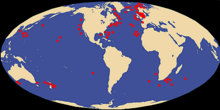Giant squid
| Giant squid | |
|---|---|

| |
| Giant squid, Architeuthis sp., modified from an illustration by A.E. Verrill, 1880 | |
| Scientific classification | |
| Domain: | Eukaryota |
| Kingdom: | Animalia |
| Phylum: | Mollusca |
| Class: | Cephalopoda |
| Order: | Oegopsida |
| Family: | Architeuthidae Pfeffer, 1900 |
| Genus: | Architeuthis Steenstrup in Harting, 1860 |
| Species: | A. dux
|
| Binomial name | |
| Architeuthis dux Steenstrup, 1857
| |

| |
| Worldwide giant squid distribution based on recovered specimens | |
| Synonyms | |
| |
The giant squid (Architeuthis dux) is a genus of deep-ocean dwelling squid. Giant squid can grow to a tremendous size: recent estimates put the maximum size at 12 metres (39 ft) or 13 metres (43 ft) for females and 10 metres (33 ft) for males from caudal fin to the tip of the two long tentacles.[2][3][4]
There is a larger squid, known as the Colossal Squid.
Until 2005, nobody had ever seen a giant squid that was alive. Only dead giant squids had been found. On 30 September 2004, researchers from Japan took the first images of a live giant squid in its natural habitat.[5] Several of the 556 photographs were released a year later. The same team successfully filmed a live adult giant squid for the first time on December 4, 2006.[6]
There is no agreement as to how many species there are. The Kraken is also believed to be a giant squid,
History[change | change source]
For many years, people would hear stories from fishermen about giant squids at sea. According to the stories, an enormous squid would wrap its arms around a whale, causing a terrible fight to start. Whalers said that sometimes, when they caught a whale, it would have scars as big as dinner plates on its body. Other times, when they cut open the stomach of some of their whales, they would find squid arms as long as 30 ft with suckers up to four inches wide. The whalers who told these stories either chopped up the squid parts to eat or use as bait, or they threw them back out to sea before scientists were ever able to examine them. However, in 1861, a French ship was able to bring back parts of a giant squid so scientists could study them.
Then, in the late 18th century, several giant squids washed up on shore, proving that giant squids really exist. After that, many giant squids were found washed ashore or dead at sea. Scientists grew very interested in these mysterious creatures, but few ever saw them alive. Scientists think they spend most of their time in deep, cold ocean.

In December 2005, the Melbourne Aquarium in Australia got the intact body of a giant squid, preserved in a giant block of ice. It had been caught by fishermen off the coast of New Zealand's South Island that year.[7]
The number of known giant squid specimens was close to 600 in 2004,[8] and new ones are reported each year.
References[change | change source]
- ↑ Allcock, L. & Barratt, I. (2014). "Architeuthis dux". The IUCN Red List of Threatened Species. 2014. IUCN: e.T163265A991505. doi:10.2305/IUCN.UK.2014-1.RLTS.T163265A991505.en. Retrieved 3 January 2018.
- ↑ McClain CR, Balk MA, Benfield MC, Branch TA, Chen C, Cosgrove J, Dove ADM, Gaskins LC, Helm RR, Hochberg FG, Lee FB, Marshall A, McMurray SE, Schanche C, Stone SN, Thaler AD. 2015. Sizing ocean giants: patterns of intraspecific size variation in marine megafauna. PeerJ 3:e715 https://doi.org/10.7717/peerj.715
- ↑ Anderton, H.J. 2007. Amazing specimen of world's largest squid in NZ. New Zealand Government website.
- ↑ O'Shea, S. 2003. "Giant Squid and Colossal Squid Fact Sheet". The Octopus News Magazine Online.
- ↑ Kubodera T. & K. Mori 2005. First-ever observations of a live giant squid in the wild.PDF Proceedings of the Royal Society B: Biological Sciences, 272(1581):2583-2586.
- ↑ "Japanese researchers capture giant squid". Fox News. December 22, 2006. Retrieved 2007-07-28.
- ↑ Holroyd, Jane (December 21, 2005). "New squid on the (ice) block". Melbourne, Australia: The Age. Retrieved 2010-08-31.
- ↑ Guerra A. A.F. González & F. Rocha 2004. A review of the records of giant squid in the north-eastern Atlantic and severe injuries in Architeuthis dux stranded after acoustic explorations.PDF (1.63 MiB) ICES Annual Science Conference 22–25 September 2004, Vigo, Spain.

